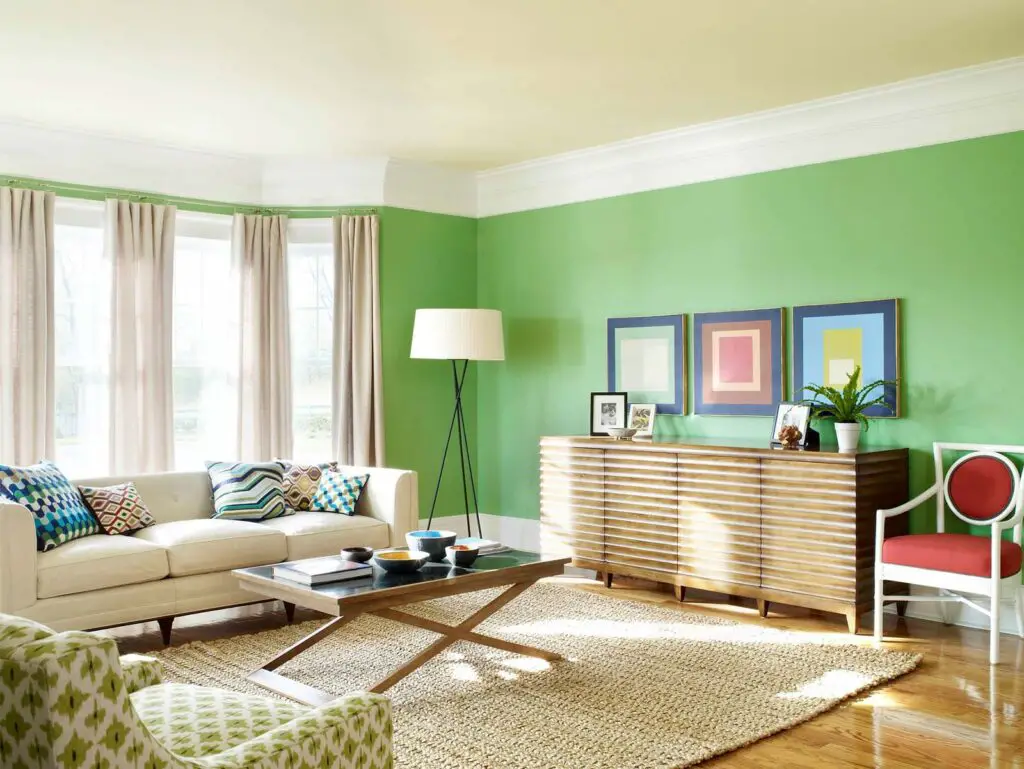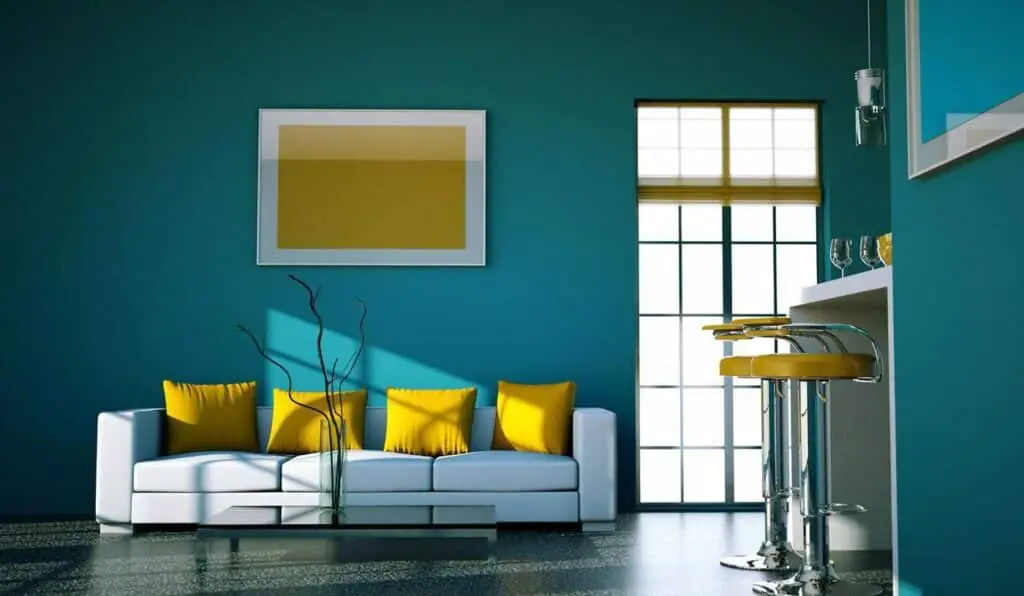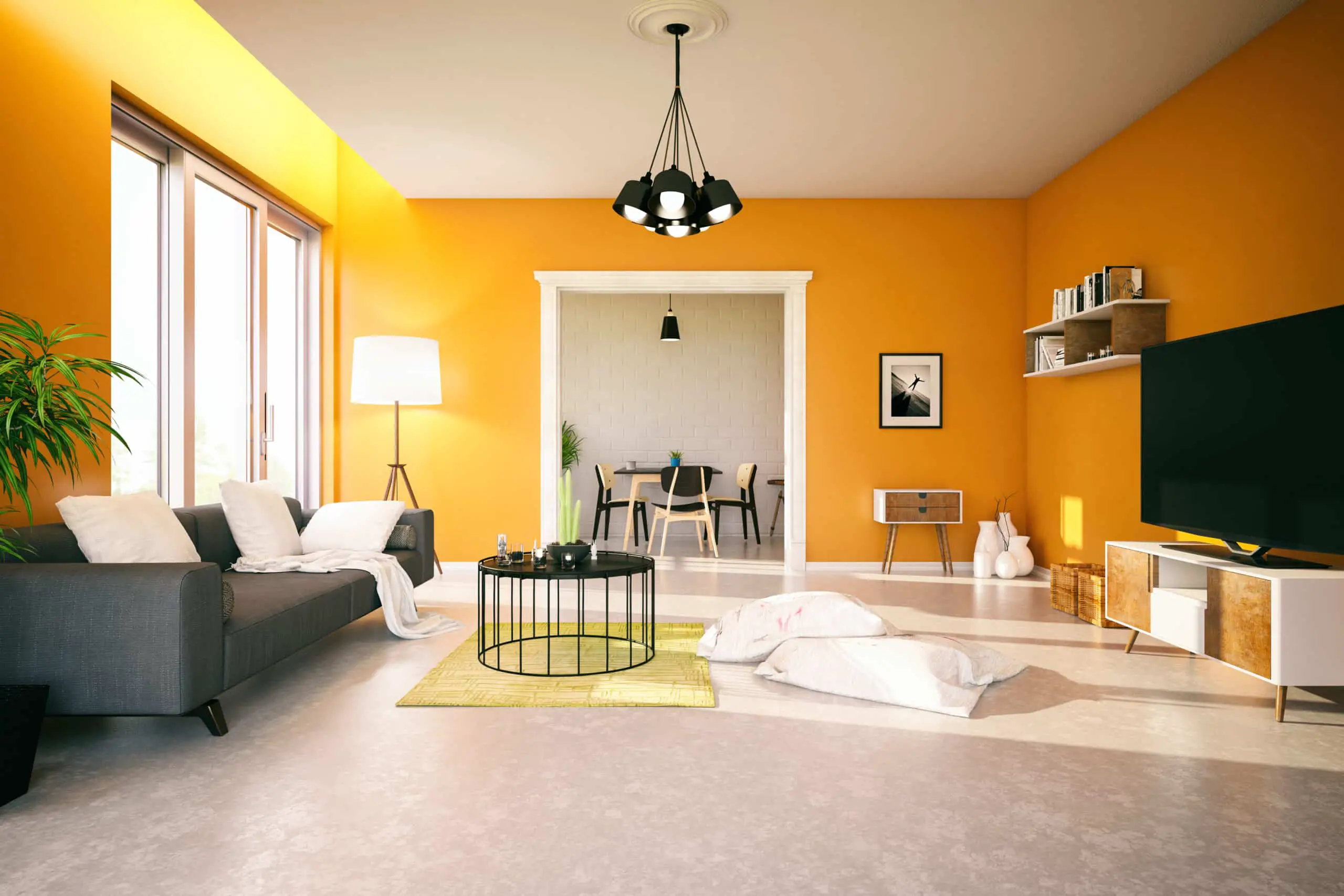How Often Paint House Interior
Introduction
How Often Paint House Interior: The question of how often to paint the interior of a house sets the stage for a journey through time, where aesthetics and practicality converge to create inviting and vibrant living spaces.
Painting the interior of a house is not only an opportunity to refresh the ambiance but also a chance to redefine the character of the space. As years go by and life unfolds within these walls, the wear and tear of daily life can leave their marks. Whether you’re seeking a dramatic transformation or simply aiming to maintain the pristine allure of your home, understanding the optimal frequency of interior painting is key.
In this insightful guide, we delve into the factors that influence the decision of when to repaint your interior wall. From the effects of foot traffic and sunlight to the durability of different paint finishes, each facet plays a role in determining how often a fresh coat of paint is needed. We’ll explore the impact of evolving design trends, personal preferences, and practical considerations that shape your decision.
Beyond aesthetics, the question of repainting your interior carries the promise of revitalizing not only the physical surfaces but also the atmosphere that envelops you. Join us as we navigate the art and science of interior painting frequency, providing insights that empower you to make informed decisions and create spaces that reflect your ever-evolving lifestyle. Your journey into the world of maintaining and enhancing your interior environment begins here.

How long does interior house paint last?
5 to 10 years
In general, interior paint will last from 5 to 10 years. You can expect your exterior paint to last between 5 to 7 years. Keep in mind that your exterior paint will be affected by regional climate conditions, the material painted, and the type of paint used.
The longevity of interior house paint depends on several factors, including the quality of the paint, surface preparation, environmental conditions, and the level of wear and tear the painted surfaces experience. Generally, here’s a rough estimate of how long different types of interior house paint can last:
High-Quality Paint: Premium-quality paints can last up to 10 years or more when applied correctly and in low-traffic areas. They tend to have better color retention and durability.
Mid-Grade Paint: Mid-grade paints typically last around 5 to 7 years. They offer decent performance but may require repainting sooner, especially in high-traffic areas.
Low-Quality Paint: Lower-quality paints may need repainting every 2 to 3 years. They tend to have lower durability and may not hold up well in busy areas.
Primer: Paint primer can extend the life of your paint job by providing a stable base and better adhesion for the paint. Using a primer can add a few years to the lifespan of the paint.
Surface Preparation: Properly preparing the surface by cleaning, sanding, and priming can significantly impact the longevity of the paint job. A well-prepared surface can make paint last longer.
Environmental Conditions: Extreme temperature fluctuations, high humidity, and exposure to direct sunlight can all affect paint’s lifespan. Areas near windows, radiators, or doors may require more frequent repainting.
Maintenance: Regular cleaning and maintenance can help prolong the life of interior paint. Dusting and gentle cleaning can prevent the buildup of dirt and grime that can wear down the paint.
How many times can you paint interior walls?
You can paint your walls in your home as often as you like. If you notice a buildup of paint, you can sand the walls down to remove it before the project. You also have the option of using a paint stripper to clean your walls before you apply a new coat of paint
You can paint interior walls multiple times as long as you follow proper preparation and application techniques. In fact, painting walls is a common part of home maintenance and interior design updates. However, there are some important considerations to keep in mind:
Surface Preparation: Properly preparing the walls before each paint job is crucial. This includes cleaning, sanding, patching holes or cracks, and possibly applying a primer. A well-prepared surface ensures the new paint adheres properly.
Quality of Paint: Using high-quality paint can extend the lifespan of your paint job. Premium paints tend to be more durable and offer better coverage and color retention.
Number of Coats: Applying multiple coats of paint can help create an even, durable finish. Usually, two coats are sufficient, but certain situations may require more.
Previous Paint Layers: Be mindful of how many layers of paint are already on the walls. If there are many layers, you might need to strip or sand down the surface before applying new paint.
Maintenance: Regular cleaning and maintenance can extend the life of your paint job. Gently dusting and cleaning walls can prevent the buildup of dirt and grime.
Color Changes: If you’re changing the wall color significantly, you may need more coats to fully cover the previous color.
Touch-Ups: For minor scuffs or blemishes, you can often touch up small areas without repainting the entire wall.
When should I paint my interior walls?
But did you know there are benefits to interior painting in the winter months? Because there is less humidity, your paint will dry noticeably faster and better in the colder months, winter is the best time for painting the exterior or the home’s interior. Don’t wait for the hot temperature, high humidity months.
The timing for painting interior walls depends on various factors, including your goals, the condition of the walls, and your schedule. Here are some scenarios when you might consider painting your interior walls:
Home Renovation or Remodeling: If you’re planning a home renovation or remodeling project that involves changing the layout or design of a room, it’s an ideal time to paint the walls. This ensures a fresh and cohesive look for the updated space.
Wear and Tear: If your walls have visible signs of wear and tear, such as scuffs, stains, or peeling paint, it’s time to repaint. Repair any damage and apply a fresh coat of paint to restore the appearance.
Color Update: If you want to change the color scheme of a room to match your evolving tastes or interior design trends, go ahead and paint the walls. Consider the current color, lighting, and furnishings when choosing a new color.
Before Selling or Renting: If you’re preparing your home for sale or rent, a fresh coat of neutral paint can make the space more appealing to potential buyers or tenants. Neutral colors create a blank canvas for others to envision their style.
Seasonal Changes: Some homeowners choose to repaint in certain seasons when they have more time for home improvement projects, like during the spring or before the holiday season.
Before Special Occasions: If you have a special event or gathering coming up, you might consider painting a room or two to refresh the space and create a welcoming atmosphere.
Maintenance: Regular maintenance can help extend the life of your paint job. Touch up areas with minor scuffs or blemishes as needed to keep the walls looking their best.
Does interior paint fade over time?
Paint in a room will typically fade uniformly over time and no one will be the wiser because there is nothing to compare it to.
Yes, interior paint can fade over time, although the extent of fading can vary depending on several factors:
Exposure to Sunlight: Sunlight, especially direct and prolonged exposure, can cause interior paint colors to fade over time. This is particularly noticeable with paints in areas near windows or glass doors.
Quality of Paint: Higher-quality paints typically contain better pigments and UV-resistant additives, which can help prevent or slow down fading. Cheaper paints may fade more quickly.
Color Choice: Some colors are more prone to fading than others. Lighter colors tend to fade less noticeably than darker ones. Vibrant or intense colors may also be more susceptible to fading.
Environmental Conditions: High humidity, temperature fluctuations, and exposure to smoke or cooking residue can affect the durability of paint and contribute to fading.
Maintenance: Regular cleaning and maintenance of painted surfaces can help extend the life of the paint job and reduce the effects of fading.
Exterior Factors: Exterior factors such as pollution or nearby industrial processes can introduce contaminants that affect the indoor air quality and may indirectly impact the longevity of interior paint.
To minimize fading, you can:
Use high-quality paint products with UV-resistant properties.
Choose lighter or more neutral colors, especially for rooms with lots of sunlight.
Use window treatments like blinds or curtains to block direct sunlight.
Maintain a stable indoor environment with controlled humidity and temperature.
Keep painted surfaces clean and free from dirt and contaminants.
While interior paint can fade over time, proper care, maintenance, and selecting the right type of paint can help prolong its vibrancy and appearance. If fading becomes a concern, you can always consider repainting or touching up the affected areas to refresh the look of your interior spaces.
How often should I paint my ceiling?
Ceilings typically don’t need to be repainted unless the room has sustained water or mold damage. However, if you’re repainting an entire room, a fresh coat of paint on the ceiling will help it match the sheen and look of the update you made.
The frequency with which you should paint your ceiling depends on several factors, including the type of paint used, the condition of the ceiling, and personal preference. Here are some general guidelines to consider:
Ceiling Condition: One of the primary factors in determining when to repaint your ceiling is its condition. If the ceiling is still in good shape, with no visible stains, discoloration, or damage, there may be no need to repaint it for many years.
Paint Type: The type and quality of paint used can impact the durability and longevity of the ceiling paint. High-quality paints tend to last longer and require less frequent repainting.
Color: Light-colored ceilings tend to show less wear and tear and may require less frequent repainting than darker ceilings.
Environmental Factors: Environmental conditions such as smoke, humidity, and cooking residue can affect the condition of the ceiling and may necessitate more frequent repainting.
Lifestyle and Habits: Personal habits and lifestyle factors can also play a role. For example, if you smoke indoors or have pets that shed, your ceiling may require more frequent repainting.
How many coats of paint is OK?
How many coats of paint do I need? Generally, you will want a minimum of two coats of paint – this is a good rule of thumb for any wall or ceiling you’re painting. You’ll rarely get a seamless finish from just one coat of paint, and even if you do, coverage isn’t the only goal when it comes to painting a room.
The number of coats of paint that is considered “OK” can vary depending on several factors, including the type of paint, the color being used, the condition of the surface, and the desired finish. Here are some general guidelines:
Two Coats: In most cases, two coats of paint are sufficient for interior walls and ceilings. The first coat provides a base layer, and the second coat ensures even coverage and a smooth finish. Two coats are also standard for most exterior surfaces.
Color Change: If you’re changing the color significantly, especially from a dark color to a light one or vice versa, you may need additional coats to achieve full coverage and an even color. Three coats might be necessary in such cases.
Primer: When using a primer, it’s common to apply one coat of primer followed by two coats of paint. The primer helps the paint adhere better and can reduce the number of paint coats needed.
Surface Condition: If the surface being painted has imperfections, such as deep scratches, stains, or discoloration that still show through after two coats, you might need additional coats to hide these issues.
Desired Finish: If you’re aiming for an exceptionally smooth, flawless finish, additional coats may be necessary. Professional painters often apply three or more coats in such cases.
Trim and Molding: Trim and molding often require extra attention. Depending on the level of detail and the desired finish, you may apply multiple coats to achieve the best result.
Quality of Paint: Higher-quality paints often offer better coverage and may require fewer coats than lower-quality paints.
Which paint is best for interior walls?
Enamel Paint –
Enamel paint is the best interior paint in India for spaces such as the kitchen and bathroom. This paint is highly durable while being water-resistant and stain-resistant which is perfect to cover metallic and wooden surfaces. This paint also provides a glossy finish with good colour retention.
The choice of paint for interior walls depends on your specific needs, budget, and preferences. Here are some common types of interior wall paint and their characteristics:
Water-Based Latex Paint: This is the most popular choice for interior walls. It’s easy to work with, dries quickly, and has low levels of fumes and VOCs (volatile organic compounds). It’s also easy to clean up with water. Water-based latex paint comes in various finishes, including flat, matte, eggshell, satin, and semi-gloss.
Oil-Based Paint: Oil-based paint provides a smooth, durable finish, but it has a longer drying time and produces more fumes than latex paint. It’s often used for high-traffic areas or areas prone to moisture, such as kitchens and bathrooms.
Paint and Primer in One: Many modern paints come with a primer built-in, which can save you time and effort. These paints are suitable for most interior walls but may not be necessary for surfaces in excellent condition.
Low-VOC and Zero-VOC Paint: If you’re concerned about indoor air quality, you can choose low-VOC or zero-VOC paints. These paints have fewer harmful chemicals and odors, making them a good choice for homes with children, pets, or individuals with allergies or sensitivities.
Specialty Paints: Depending on your needs, you might consider specialty paints. For example, you can use washable or scrubbable paint in high-traffic areas or rooms prone to stains. Chalkboard or magnetic paints are fun options for playrooms or kitchens.
Finish: The finish you choose can affect the look and durability of the paint. Flat and matte finishes hide imperfections but are less washable. Eggshell and satin finishes are washable and have a slight sheen. Semi-gloss and gloss finishes are highly washable and suitable for trim and high-moisture areas.
What is the best time of day to paint?
Everyone agrees that early morning is the absolute best time to begin a painting job. There is plenty of natural light streaming in, and you have hours to get the job done. When you open all of the windows and doors, you can control and minimize the “new paint smell” that you will have throughout the day.
The best time of day to paint depends on the type of paint you’re using and the environmental conditions in your area. Here are some general guidelines:
Morning: If you’re using water-based latex paint, the morning is often the best time to paint. The temperature and humidity levels are usually more moderate at this time, which helps the paint dry and cure evenly. Additionally, painting in the morning allows more time for the paint to dry before nighttime dew or cooler temperatures set in.
Avoid Midday Sun: Avoid painting during the hottest part of the day, typically between 10 a.m. and 3 p.m., especially if you’re working with oil-based or solvent-based paints. High temperatures can cause the paint to dry too quickly, leading to issues like brush marks and uneven coverage.
Afternoon: In some climates, painting in the late afternoon can be a good option, as temperatures begin to cool down. However, be mindful of the changing light conditions as the sun sets.
Evening: Painting in the evening is generally not recommended, as the decreasing temperatures and rising humidity can negatively affect the paint’s drying and curing process. If you must paint in the evening, make sure the room is well-ventilated to help with drying.
Consider Lighting: Adequate lighting is crucial for a successful paint job. If you’re painting indoors, ensure you have good artificial lighting, as natural light can change throughout the day and affect how you perceive the paint color.
Weather Conditions: Always check the weather forecast before starting a paint project. Sudden rain or extreme weather conditions can ruin a fresh paint job.

Conclusion
The rhythm of interior painting is a dance between creativity, maintenance, and the ever-changing canvas of life. The question of how often to paint the house interior is a harmonious interplay of practicality and aesthetics, where the passage of time creates a natural cadence for renewal.
As we’ve explored the factors that guide this decision—sunlight, wear and tear, design trends, and personal taste—we discover that the frequency of repainting holds the power to refresh and rejuvenate house interior. It’s an opportunity to breathe new life into walls that have witnessed countless moments, making them a reflection of both the past and the future.
With each brushstroke, homes evolve, adapting to evolving lifestyles and aspirations. The journey to maintain a beautifully maintained interior is an investment in comfort, inspiration, and the ongoing story of your dwelling. As you contemplate the rhythm of repainting, remember that every layer of paint is more than just color; it’s an expression of your evolving identity, transforming your house into a canvas of both memories and dreams.








